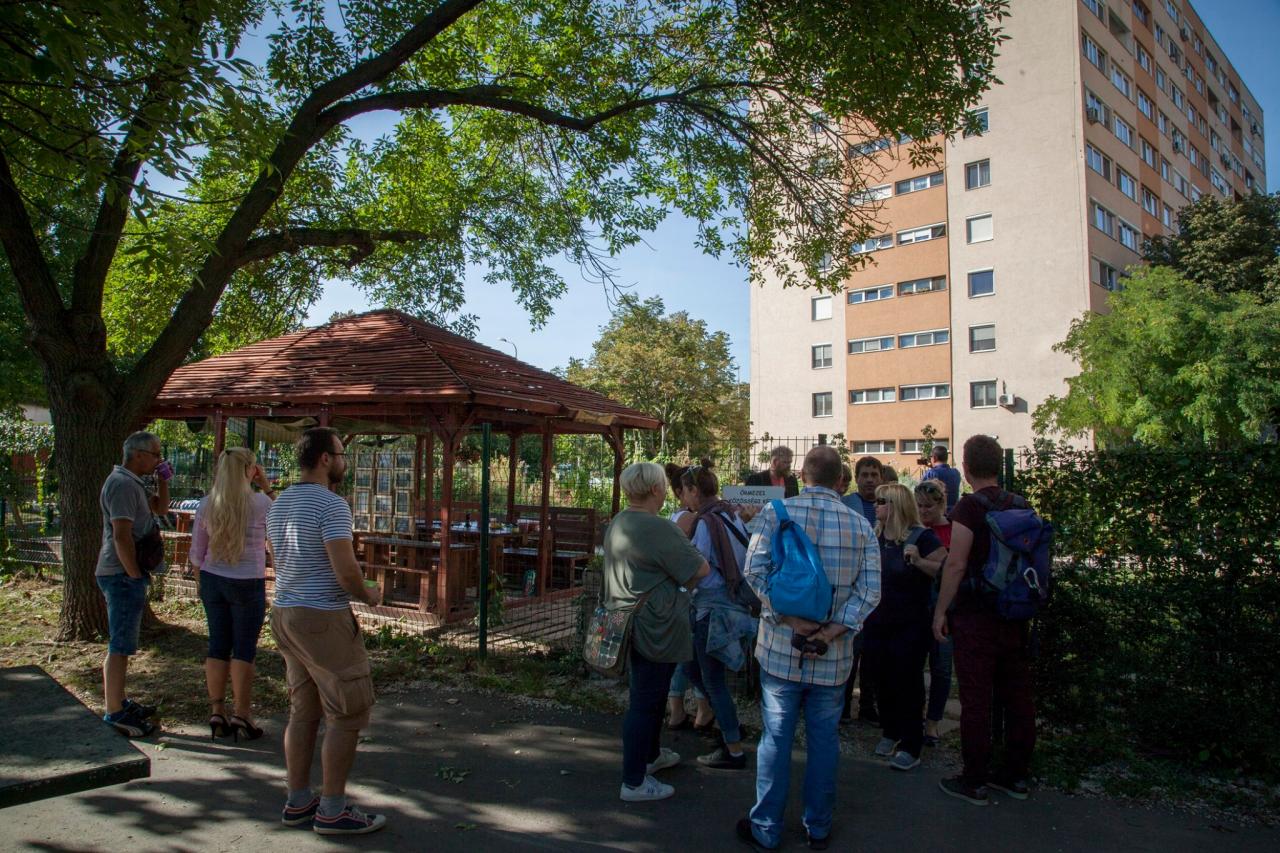
Although the first prefabricated buildings were built in Western Europe after the Second World War, they are undoubtedly the synonyms of the post-soviet countries like Hungary. Negative connotations towards prefabricated housing estates neglects the diversity of these areas and their diverse development processes in past years. Undoubtedly, their judgement has been changing, and it is perhaps time to revalorise these areas. We made a very first attempt in the Come in! Transfer Network to do that by organising a pilot community festival in Őrmező.
Why to celebrate prefabricated housing estates?
Although the first prefabricated buildings were built in Western Europe after the Second World War, they are undoubtedly the synonyms of the post-soviet countries like Hungary. Negative connotations towards prefabricated housing estates neglects the diversity of these areas and their diverse development processes in past years. Undoubtedly, their judgement has been changing, and it is perhaps time to revalorise these areas. We made a very first attempt in the Come in! Transfer Network to do that by organising a pilot community festival in Őrmező.
Revival of prefabricated housing estates?
Municipality of Újbuda, district 11 of Budapest transfers the good practice of Budapest100 in Őrmező, which is a typical, but relatively small housing estate at the western gate of Budapest, built during the 80ies. Actually, due to its size and compactness, Őrmező is a showcase of prefabricated housing estates built during the Socialism. It is typical, but yet, somehow unique, at least in comparison with the average similar neighbourhoods. What is visible for anyone is that all houses are insulated and in front of the buildings almost all little gardens are well cultivated. It is also easy to realise that Őrmező is very green, there are lots of trees, which is, again, not usual, at least in Hungary. If you go further, you can also explore one of the best community gardens of Budapest here and you can listen locals saying hello to each other regularly, which is not common unfortunately in such a place. Indeed, local people call the two parts of Őrmező as “lower” and “upper village” just as people did it traditionally in villages. If you talk with locals, the community spirit becomes more and more tangible. The huge houses were insulated among the first ones in Budapest as local people could do that jointly via housing cooperatives. In other cases the process often took long years, and it is also typical that one house is insulated, the other is not.
But Őrmező – which has been so far rather isolated by the motorway and train tracks - is changing since the new metro line ends up here now, and all around new shopping malls and office buildings are under construction. This is why the municipality decided to test the good practice (a two-day long community festival co-organised by local residents and a massive group of volunteers to highlight values of the built environment as well as common values to decrease urban isolation) here, to stimulate and strengthen the still existing community spirit. It might seem strange for the first sight to celebrate such a place, but the motto of Budapest100 is that every single house is interesting. Actually it seems a very good idea as prefabricated housing estates definitely have bad reputation among citizens in Hungary and most likely in other surrounding countries too, however, these flats are more and more popular on the property market and Őrmező is one of the best prefabricated housing estates in Budapest according to surveys.
Hundreds of thousands people live in these areas, so indeed it is important to clarify the above contradiction and change the general judgement of these neighbourhoods, and organising a community festival highlighting not only the built environment, but also common values and neighbourhoodness seems a great opportunity to start a broader discussion on this crucial topic to change attitudes.
In a sunny Sunday afternoon in early September locals gather in the centre of Őrmező around a temporarily exhibition. All items of the exhibition were initiated by locals, and prepared by some volunteers and mainly by the Contemporary Architecture Centre and the local cultural house coordinating the event. Visitors could read not only about the history of the local mineral water fountains, once well-known in the whole country, search themselves on old school photos, recall old times by sitting in old furniture, get to know the local history and some local urban legends placed on a huge timeline, play retro board games, create panel blocks by paper, and so on, but they actually could share their ideas how to improve the community festival and how to develop the area.
It was one of the very first attempts to transfer the good practice within the Come in! Talking Houses / Shared Stories URBACT Transfer Network and obviously many principles of the good practice have been tackled inappropriately. The lack of personal storytelling reflecting on the built environment, the lack of due community actions and especially family programs in different locations made the festival less community-based. Yet, within the Come in! network we believe that such a festival can pave the way for and contribute to the revalorisation of dissonant or brutal heritage just as the prefabricated housing estates built during the Socialism and initiate a professional discussion on it.
From utopia to nightmare
Critics often forget that prefabricated housing estates meant efficient answer to the massive housing shortage Europe faced at that time when they were built. Representing modernism, they really meant shockingly big change for the newcomers in the city: people found relatively big flats with modern toilets, kitchens and central heating. From this aspect Őrmező was built as an ideal place: all flats here were bigger than the average at that time, all flats with one and a half room have 55 square meters. Originally 2250 flats were planned with kindergarten, school and services at the centre. Finally it was finished in 1984, with 3088 flats, and the “big dream” become less heavy: only 10-floor houses were built instead of the originally planned 15-20-floor buildings. These unified, ‘template’ flats have become unique over the time, residents made their flats unique by for example using Mediterranean elements or made angled corners rounded, providing an essential source for anthropologists.
These residential areas obviously have a bad reputation in the Hungarian society, but I guess, it is the same in all post-soviet countries. Although their quality are definitely not the same, they were built as utopias for the worker class in Central Europe. These areas meant a new community space, a laboratory of Socialism where blue-collar workers used to live together with professors. But then their image quickly changed, which is even proven in some Hungarian cartoons from that time documenting how they transformed from ideal places to nightmares. This phenomenon is even stranger if we take into consideration the fact that in Western Europe many of these housing estates soon became marginalised, but in Central-Europe few of them are really slum, most of them provides life for many different, middle-class people. Most likely this stubborn negative attitude towards “panel districts” were born as services were often poorly developed once the buildings had been finalised. Also, planners often forgot to plan community and “in-between” spaces – to (re)define and create such places now calls a need for community actions.
Whatever was the reason of this negative attitude, the trend seems turning over: generally speaking these flats are popular on the property market in Budapest and also prefabricated building techniques are more and more popular. Not to mention that exploring the sensitive built heritage is also a new, tangible trend in Hungary: there is a growing attention to them realised by thematic walks or initiatives highlighting the values of those buildings (e.g. moderngyor.com or retropolisz.com)
So what to do with a community festival in Őrmező?
The transfer process in Őrmező has the potential to grow bigger in Hungary, or at least in Budapest, to have a much bigger impact by initiating a discussion on and revalorise these prefabricated areas. In order to do that the local government should step back and found ways to create an environment where a truly bottom-up festival could be born. In that case not only the flat prices would rise at Őrmező, but the level of local trust and the feeling of belonging too.
Celebrating and organising a feast is a core part of the community building tools. Celebration is a big part of common culture that creates an opportunity to bond together and establish deep trust. Celebration helps locals to focus on where they live, but doing something voluntarily for our own neighbourhood and create/strengthen an emotional connection through participatory placemaking actions can really knit communities together.
Mobilising citizens is a key to make many urban policies successful, and celebrating common values along the built environment, strengthening the feeling of belonging and this way enhancing local social networks is a great tool to start this difficult process.
Hopefully this very first attempt at Őrmező can lead to a symbolic projects next year, creating points of energy and initiating a snowball effect. Perhaps in one year Budapest100 will be about reflecting on prefabricated housing estates across Budapest.

